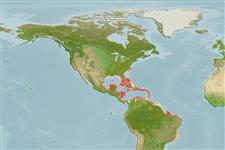Common names from other countries
>
Eupercaria/misc (Various families in series Eupercaria) >
Labridae (Wrasses) > Corinae
Etymology: Halichoeres: Greek, als, alis = salt + Greek, choiros = pig (Ref. 45335).
More on author: Bloch.
Environment: milieu / climate zone / depth range / distribution range
экология
морской ассоциированный с рифами; пределы глубины 1 - 15 m (Ref. 9710). Tropical; 37°N - 26°S, 100°W - 28°W
Western Atlantic: North Carolina, USA and Bermuda to Brazil (Ref. 7251).
Size / Вес / Возраст
Maturity: Lm ? range ? - ? cm
Max length : 35.0 cm TL самец/пол неопределен; (Ref. 55367); наибольший вес (опубликованные данные): 146.00 g (Ref. 9626)
колючие лучи спинного плавника (общее число) : 9; колючие лучи анального плавника: 3; членистые (мягкие) лучи анального плавника: 12. The dominant color markings are two dark stripes, one running from snout through eye to caudal base and the other, less pronounced, on lower side of body; a bicolored spot at edge of gill cover within upper dark stripe; large adult males green on back, shading to light greenish yellow on sides, the two stripes usually purplish; irregular light red bands on head and on caudal fin (Ref. 13442).
Commonly found in rocky and reef areas in shallow waters. Less common in seagrass beds. Feeds on other fishes (Ref. 5521) and gastropods (Ref. 9626). Forms leks during breeding (Ref. 55367). A protogynous hermaphrodite (Ref. 55367).
Life cycle and mating behavior
Maturities | размножение | Spawnings | Egg(s) | Fecundities | личинки
Diandric. Pelagic spawner (Ref. 32222). Sex reversal is completed in more than 3-4 weeks (Ref. 34185, 34257). Length at sex change = 30.2 cm TL (Ref. 55367).
Robins, C.R. and G.C. Ray, 1986. A field guide to Atlantic coast fishes of North America. Houghton Mifflin Company, Boston, U.S.A. 354 p. (Ref. 7251)
Статус Красного Списка МСОП (Ref. 130435)
CITES (Ref. 128078)
Not Evaluated
Угроза для людей
Harmless
Использование человеком
рыболовство: коммерческий; аквариум: коммерческий
дополнительная информация
инструменты
Специальные отчеты
Скачать в формате XML
ресурсы в Интернет
Estimates based on models
Preferred temperature (Ref.
115969): 24.4 - 28.2, mean 27.3 (based on 713 cells).
Phylogenetic diversity index (Ref.
82804): PD
50 = 0.5000 [Uniqueness, from 0.5 = low to 2.0 = high].
Bayesian length-weight: a=0.00912 (0.00581 - 0.01432), b=3.07 (2.94 - 3.20), in cm Total Length, based on LWR estimates for this species & Genus-body shape (Ref.
93245).
Trophic level (Ref.
69278): 3.8 ±0.1 se; based on diet studies.
устойчивость к внешним воздействиям (Ref.
120179): средний (среднего размера), минимальное время удвоения популяции 1.4-4.4 года (Preliminary K or Fecundity.).
Fishing Vulnerability (Ref.
59153): Low vulnerability (25 of 100).
